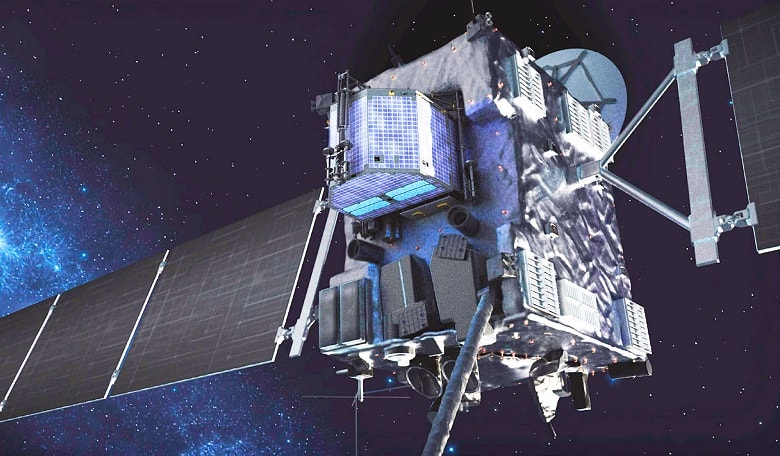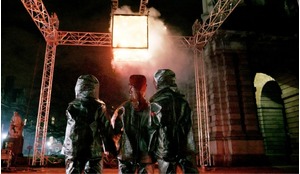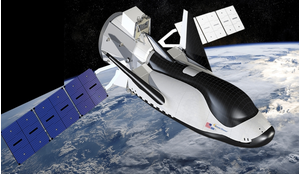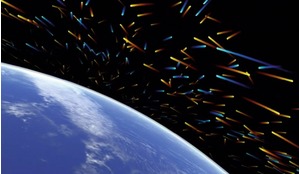The Rosetta mission was technically one of the most challenging missions that ESA and European industry has had to implement and conduct to this day. In our humble opinion, we believe that the Rosetta mission can be considered the ‘Apollo’ moment of our decade. It has not only enthralled the general public but, as we have witnessed, has also inspired artists and musicians from around the world to produce art works in response to this daring space mission.
In late 2013, Design & Data GmbH was approached by ESA with a request for several short films to promote the Rosetta mission. ESA was keen to create great content that could help to generate some attention for a competition linked to the Rosetta mission. The brief contained various types of videos. One stuck out in particular: ESA requested the creation of an illustrated fairytale video describing the story of Rosetta, which was in deep-space hibernation at the time, using the ‘Sleeping Beauty’ theme.
At the time we had become interested in cartoon animation due to a new recruit to our team. We therefore proposed to ESA to depict the Sleeping Beauty style fairytale video to promote Rosetta as a cartoon animation and eventually ESA decided to turn the successful video into a whole cartoon series to follow and communicate the mission adventures.
The design of the look and feel of the Rosetta cartoon series featured two main characters - the spacecraft Rosetta, and the lander, Philae, which Rosetta delivered to the comet on 12 November 2014.
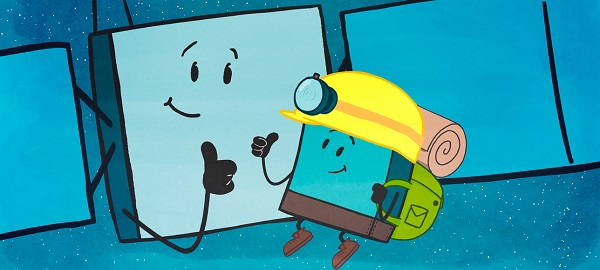 ‘Once Upon a Time….’ cartoon series. Rosetta bids her lander farewell and sends him to the comet’s surface
‘Once Upon a Time….’ cartoon series. Rosetta bids her lander farewell and sends him to the comet’s surface
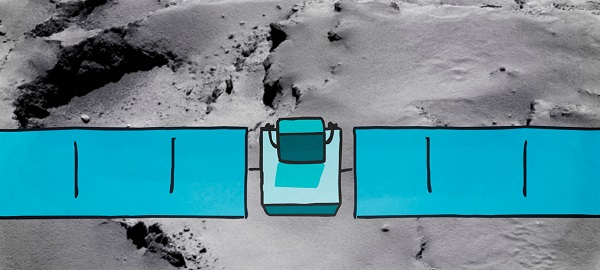 Rosetta above the comet
Rosetta above the comet
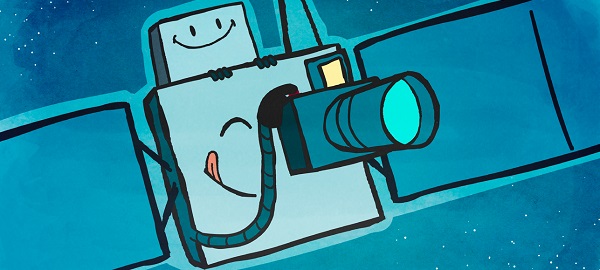 Rosetta takes a photo
Rosetta takes a photo
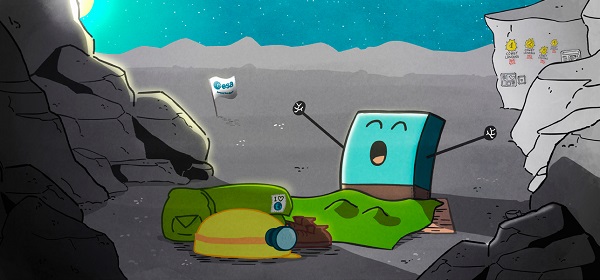 Without enough sunlight to keep him powered, Philae ‘fell asleep’ after about 60 hours of operation. Here he is waking up after seven months’ rest in a shady spot on Comet 67P
Without enough sunlight to keep him powered, Philae ‘fell asleep’ after about 60 hours of operation. Here he is waking up after seven months’ rest in a shady spot on Comet 67P
We worked together with ESA’s team of science communicators on scripting, storyboarding, designing, animating, and producing the cartoon episodes. The spacecraft cartoon characters also gained popularity in synergy with the Twitter accounts @ESA_Rosetta (managed by ESA’s science communications team) and @Philae2014 (managed by the German Aerospace Centre, DLR), which were run in first person, letting the public engage with the characters of Rosetta and Philae on their adventure to explore Comet 67P/ Churyumov-Gerasimenko.
Compared to Earth observation, navigation and telecommunication satellites, space exploration missions are not often readily seen to offer a tangible monetary return on investment. It is therefore even more essential to engage target audiences on an experience level by finding ways in which they can become part of the adventure (Harris & Russo, 2015). [2] One of the many ways to communicate the experience of adventure is to connect to the audience on an empathy level by bringing in human factors - and this cartoon series, as part of ESA’s wider outreach campaign, demonstrates that this can be a successful strategy.
Ideas for the future
We believe that space exploration missions benefit from the involvement of communication experts or storytelling engineers. This involvement provides inputs already at the mission planning stage, and can be worked in a concurrent design facility. While the spacecraft undergoes changes as each subsystem is discussed by subsystem engineers, the storytelling engineer can provide inputs as to how each subsystem may contribute to engaging the general public during the different stages of the mission.
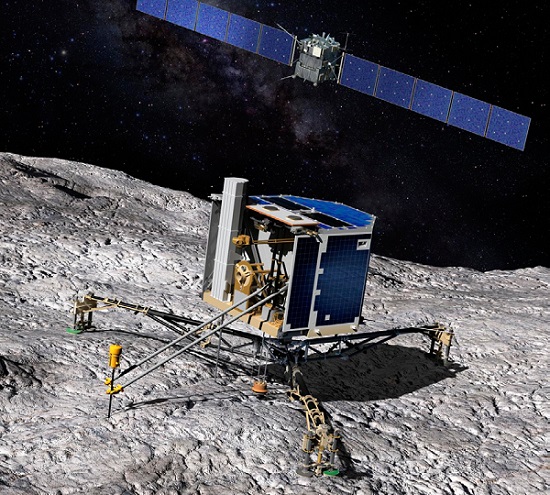 Artist’s impression showing Philae on the comet’s service and Rosetta
Artist’s impression showing Philae on the comet’s service and Rosetta
Communication should therefore not be something that happens once the mission is launched but becomes part of the whole planning and development process; to build not only a spacecraft but also a whole space exploration mission brand with its associated space mission experience for the benefit of the general public.
A mission statement and a script with potential conflict points (ie, risk points that need to be overcome within the mission) make useful planning tools. Talking about the risks openly bring the human dimension into a mission, as demonstrated with the live coverage of key events with Rosetta.
Creating empathy
Looking at perfectly engineered spacecraft and complex payloads alone do not always instill emotions of the general public. Nor do they always immediately instil a desire in our youth to go and pursue engineering as a career choice or feel passionate about STEM education.
In our paper we decided to look at ways of measuring empathy and how the public perceived the Rosetta cartoon characters. We explored the different methods adopted in ‘measuring’ empathy. Prof Mark Davis, a behavioural sciences specialist who defines empathy as the reactions of one individual to the observed experiences of another, considered a mixed ‘multidimensional approach’ as he sought to measure individual differences in empathy in his Interpersonal Reactivity Index (IRI). It lists 28 questions relating to empathy, with four sub-scales: Empathic Concern (EC), Perspective Taking (PT), Personal Distress (PD) and Fantasy Scale (FS). We explored these subscales in a survey based upon the IRI. [3, 4]
ESA requested the creation of an illustrated fairytale video describing the story of Rosetta using the ‘Sleeping Beauty’ theme
Anthropomorphism was shown to break down the barriers that existed thus far between the general public and space exploration missions. Empathic concern for Philae was felt everywhere when the spacecraft went into hibernation and lost contact with Rosetta and, subsequently, with Earth on the night between 14 and 15 November. Our survey results showed how anthropomorphism managed to bring the spacecraft closer to us, by enabling the public to connect with the characters on these different empathy sub-scales.
While the first-person Twitter accounts of Rosetta and Philae, often engaged in lively conversations with one another, already created a sense of closeness between the audience and the two space mission heroes, the visual depictions of the anthropomorphic characters we consider are a strong communication tool for building an empathic connection with the spacecraft. A milder anthropomorphic approach was used in the cartoon style. This involved a simple, reduced representation of the spacecraft, and was also an important element that was chosen to avoid the ‘Uncanny Valley’(Mori, 1970). [5]
Number of characters
Storytelling requires protagonists. The right choice of protagonists may result in diverse types of stories to be told. In the case of Rosetta and Philae, there were two protagonists that complemented each other quite easily. The narrative evolved as a classic road trip story into the depths of our universe. In other space exploration missions, we may not have protagonists other than the main spacecraft. A story, however, lives from conflict and interaction to resolve these conflicts. We believe it is therefore important to have at least two protagonists in the story. If no second spacecraft is available, then instrument payloads could be used as protagonists to develop lovable characters for which the general public can feel empathy.
Look and feel
From our experience with Rosetta and Philae, we wanted to create a handmade look so that people feel visually attached to the animations. It should instil a feeling of preciousness in the viewer. By no means were we trying to create realistic-looking characters to avoid problems that instil a feeling of eeriness (ie, ‘Uncanny Valley’) in the viewer. The creation of a loveable and memorable spacecraft is an importaqnt element to help the public engage with the mission. This encompasses thinking about how to make characters distinctive, which link qualities to use to describe them visually, choosing colours and the range of facial expressions.
Creating engagement
In order to identify with a space exploration mission, it is essential to build bridges to the general public. The public needs to live and feel as if they are part of the adventure. In the case of the Rosetta mission, we found from our survey that a large part of the general public felt empathetically connected with the cartoon characters we created. This connection really came alive when combined with the conversations between Rosetta and Philae on Twitter, and when cartoon images were released during these discussions. This relied on close coordination between ESA and DLR scripting the tweets, and between ESA and DLR on the images. It also helped that many people were already primed with knowledge about Rosetta and Philae via extensive coverage in the broadcast and print media, as well as by a wide distribution over the web.
An unexplored avenue for creating additional engagement may involve finding branding partners for space missions
Another important element was that the mission itself also had an open, human face, via some of the members of ESA’s Rosetta team, further increasing the emotional, empathic connection with the public. This ‘human element’ of the outreach campaign was also the subject of discussion by journalists.
Participation through competitions was another useful tool to engage members of the public to feel connected to the mission. Telling a story across multiple media outlets is essential in creating the success we found with Rosetta. [6]
 OSIRIS narrow-angle camera image taken on 23 January 2016 when Rosetta was 75.1 km from Comet 67P/Churyumov- Gerasimenko (the scale is 1.37 m/pixel)
OSIRIS narrow-angle camera image taken on 23 January 2016 when Rosetta was 75.1 km from Comet 67P/Churyumov- Gerasimenko (the scale is 1.37 m/pixel)
An unexplored avenue for creating additional engagement may involve find branding partners for space missions in order to create further connections in everyday life. ESA did create Rosetta water bottles that were given away at events and in competitions but taking the example of the American TV series True Blood, which made a synthetic beverage that enabled vampires to ‘live among humans’, deep space missions such as Rosetta could partner with a drinks company on something like a ‘comet water’ fizzy drink. Partnerships like this are not generally encouraged by public science organisations such as ESA and NASA; and whether this arrangement would work from a legal perspective is beyond the scope of this article. When restricted communication budgest are available, we feel it is important to reconsider if such partnerships offer greater benefits and more potential for reaching out to the general public and engaging them with the space exploration mission brand.
1 Marcu, S.D., & Laird, R. J. M. (2015). Rosetta and Philae: Captivating the Hearts and Minds of a Global Audience, 66th International Astronautical Congress, Jerusalem.
2 Harris, H. E., & Russo, P. (2015). The influence of social movements on space astronomy policy. Space Policy, 31, 1-4. Instrumentation and Methods for Astrophysics.
3 Davis, M. (1980). A multidimensional approach to individual differences in empathy. Catalog of Selected Documents in Psychology 10, 85.
4 Davis, M. H. (1983). Measuring individual differences in empathy: Evidence for a multidimensional approach. Journal of Personality and Social Psychology.
5 Mori, M. (1970), ‘The Uncanny Valley’, Energy. vol. 7, no. 4, pp. 33-35 (in Japanese).
6 Jenkins, H. (2003). Transmedia storytelling. Moving characters from books to films to video games can make them stronger and more compelling. Technology Review.
Acknowledgement
The authors wish to thank the ESA communications team for their input and feedback on this article. All episodes of the cartoon series and outreach resources for the mission can be found at: http://sci.esa.int/rosetta/53593-outreach-resources/





